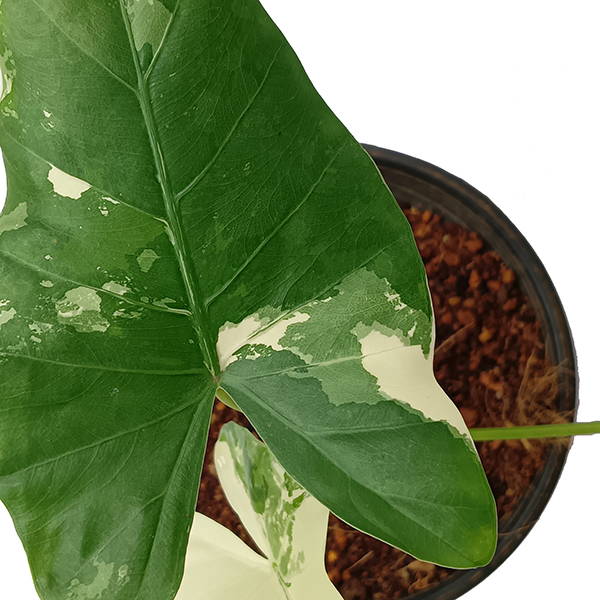
Common Name: Brasil, Lemon, Heart Leaf Philodendron, Birkin, Mia, Florida Green, Prince of Orange, Ring of Fire and many more!
Botanical Name: Philodendron hederaceum, Philodendron cordatum, and many hybrid upright and vining species., Family: Araceae
Upright Growing Philodendron
If you like your plants big and mindless, then you are going to love ALL the upright forms of philodendron! In fact these indoor plants grow slower than the climbing forms of philodendrons, but do in fact sprawl out over time, like a very slow growing vine. Another fact about these upright forms, is that they grow large, with the right care and enough time, you will want to either trim them back to keep them under control, or you can enjoy them in their more mature stage in life! As they age, you might have to stake them to help support the weight of the large leaves and thick stems (Philodendron giganteum, Pink Princess, Lemon Lime, etc). In most cases upright forms of philodendron will not get massive indoors, rarely will they grow beyond 5′ tall and wide, but if your space has lots of indirect light, high humidity and relatively warm temperatures (greenhouse conditions, baby!), then they will be in the most ideal conditions and will reach their full growth potential! You do NOT need a greenhouse to have perfectly beautiful and healthy philodendron. They adapt easily to many light levels, temperatures and humidity levels!
Vining Philodendron
We love all vining forms of philodendron because they are fearless and fierce growers while looking gorgeous doing it! Indoor plants that hang, trail, climb and cling are our thing! Climbing philodendron use aerial roots to cling on to surfaces to gain access to light. It is in their DNA to find the light source and when they do, their leaves will become large, and in some cases, change form. There are so many species of vining philodendron that are suitable to grow indoors like the lovely Brasil, the heavenly brandtianum and the classic Heart Leaf Philodendron. Calling them hardy houseplants is an understatement as they can go for long periods of time without water, but it is important to make sure they are watered when you see their leaves start to droop down.
You have many choices when it comes to displaying these magnificent vines! Try letting them cascade off of a table top or counter. Supply them with a stake and encourage them to grow up vertically. Plant different varieties together to create a rainbow of greens, yellows and deep reds. A clean plant is a happy plant. Make sure to wash their leaves every month to allow them to undergo photosynthesis.
Light
Philodendrons prefer medium to bright indirect sunlight, but can live in lower light conditions. However, their leaves will be smaller and the vines will become leggy if the light is not bright enough. Read more about indoor plant lighting needs!
Water
Water the soil thoroughly after the soil is almost completely dry. It is a good indication that it needs water when the leaves start wilting. Water more often in the growing season and reduce the frequency during the winter months. It is best to refrain from watering if you cannot decide if its time to add more. Larger plants can go weeks without water, but younger, less established plants need to be watered on a regular basis until their roots have fully developed.
Soil
All philodendrons love loose, nutrient-rich potting soil. Use a soil medium that can retain moisture but also allows for draining excess water to avoid root rot. Most pre-mixed soils will suffice. Make sure that there is plenty of organic matter, like coco-coir, peat moss, or shredded leaves, and avoid soils that contain moisture retaining crystals. If your soil drains too quickly, we recommend re-potting into a compost-rich soil mixture, with less drainage materials. Learn how to create your own universal soil mixture for all of your indoor plants!
Temperature
Most household temperature ranges are adequate for these indoor plants. Letting them remain in temperatures under 55℉ will stunt their growth. Prolonged exposure to cold temperatures can be fatal for these tropical indoor plants.
Humidity
As with most tropical indoor plants, Philodendrons will benefit from higher humidity, but will do fine in average household air. Higher humidity (over 50%) is always better for tropical houseplants. Learn how to increase the humidity in the air around your indoor plants!
Fertilizer
This genus of indoor plants benefits greatly from regular fertilizing. Use a weak solution of a complete liquid fertilizer every two weeks throughout the growing season. Do not fertilize during the winter months. Sometimes your indoor plants will grow all year long. If this is the case, fertilize them during times of obvious foliage growth with a ¼-strength diluted liquid fertilizer, or top dress the soil with worm castings or rich compost. Learn more about how to fertilize your indoor plants.
Growth Rate
Vining, small-leaved philodendrons are moderate to fast-growing indoor vines and once established can grow to 10’+ indoors! Its best to keep them pruned to maintain a full, lush form. Non-vining philodendrons are slow-medium growers indoors. If they are given proper care and placed in a warm, bright environment, then they can give you all they can give!
Pro Tips
When you trim back vines to make your plant fuller, you can propagate the cuttings.
Staking your plant to climb upwards encourages larger leaf development.
For philodendrons with colorful leaves, maintain their vibrancy by providing more light.
Leaf drop is normal for indoor plants when they are acclimating to their new home. Although if many leaves are lost, then it could be other issues like over or under watering or a lack of light.
Sometimes we over-love our indoor plants! Read about houseplant mistakes to avoid!





